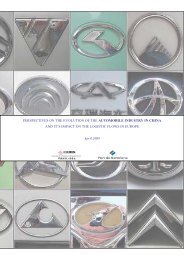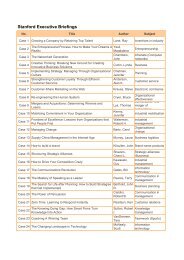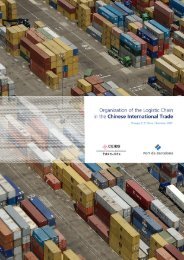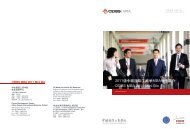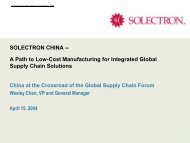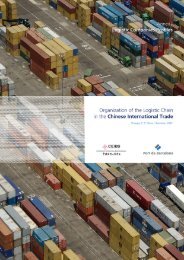Capital Abundance and Developing Country Production Patterns
Capital Abundance and Developing Country Production Patterns
Capital Abundance and Developing Country Production Patterns
You also want an ePaper? Increase the reach of your titles
YUMPU automatically turns print PDFs into web optimized ePapers that Google loves.
Moving beyond the simple correlation shown in Figure 1, we use regressions to isolate the<br />
effect of capital abundance by controlling for other factors that influence production patterns.<br />
Our empirical investigation uses the estimation approach of Harrigan <strong>and</strong> Zakrajšek (2000),<br />
which is developed from the GDP function method of Diewert (1974) <strong>and</strong> Kohli (1978). The<br />
Harrigan-Zakrajšek approach uses panel-data regressions to account for differences in technologies<br />
<strong>and</strong> commodity prices without measuring them. In their study of the Rybczynski effects<br />
in a sample of 21 industrialized countries <strong>and</strong> 7 relatively advanced developing countries (Argentina,<br />
Chile, Hong Kong, Korea, Mexico, Turkey, <strong>and</strong> Taiwan) with four factors (unskilled<br />
labor, skilled labor, capital, <strong>and</strong> l<strong>and</strong>) <strong>and</strong> 10 sectors (grouped from 3-digit ISIC industries),<br />
they found that the estimated Rybczynski effects have the expected signs in a significant number<br />
of industries, particularly in large industries that are not natural-resource based.<br />
Our finding contrasts sharply with that of Harrigan <strong>and</strong> Zakrajšek (2000). We find capital<br />
abundance to be statistically significant in determining production patterns in 18 of the 28<br />
industries (Table 3). However, the signs are opposite to what the st<strong>and</strong>ard HO model predicts.<br />
In our full-sample panel-data regressions controlling for time <strong>and</strong> country fixed effects as well<br />
as industry skill level (proxied by industry average wage rate relative to the US), the valueadded<br />
shares of all of the 12 relatively labor-intensive industries increase with country capital<br />
abundance, with six of them statistically significant, <strong>and</strong> the value-added shares of 12 of the 16<br />
relatively capital-intensive industries decrease with country capital abundance, with six of the<br />
12 statistically significant (Table 4).<br />
A valid application of the Harrigan-Zakrajšek regression equation requires conditional factor<br />
price equalization for countries in the sample. 1<br />
Performing a test of conditional FPE that<br />
estimates the correlation between industry capital intensity <strong>and</strong> country capital abundance in<br />
1 If factor prices are not equalized conditional on technology differences, countries would produce different<br />
sets of goods, <strong>and</strong> the estimated Rybczynski effect would switch signs with respect to different levels of capital<br />
abundance (Leamer, 1987). Estimating a single Rybczynski equation in this case is not valid.<br />
3




